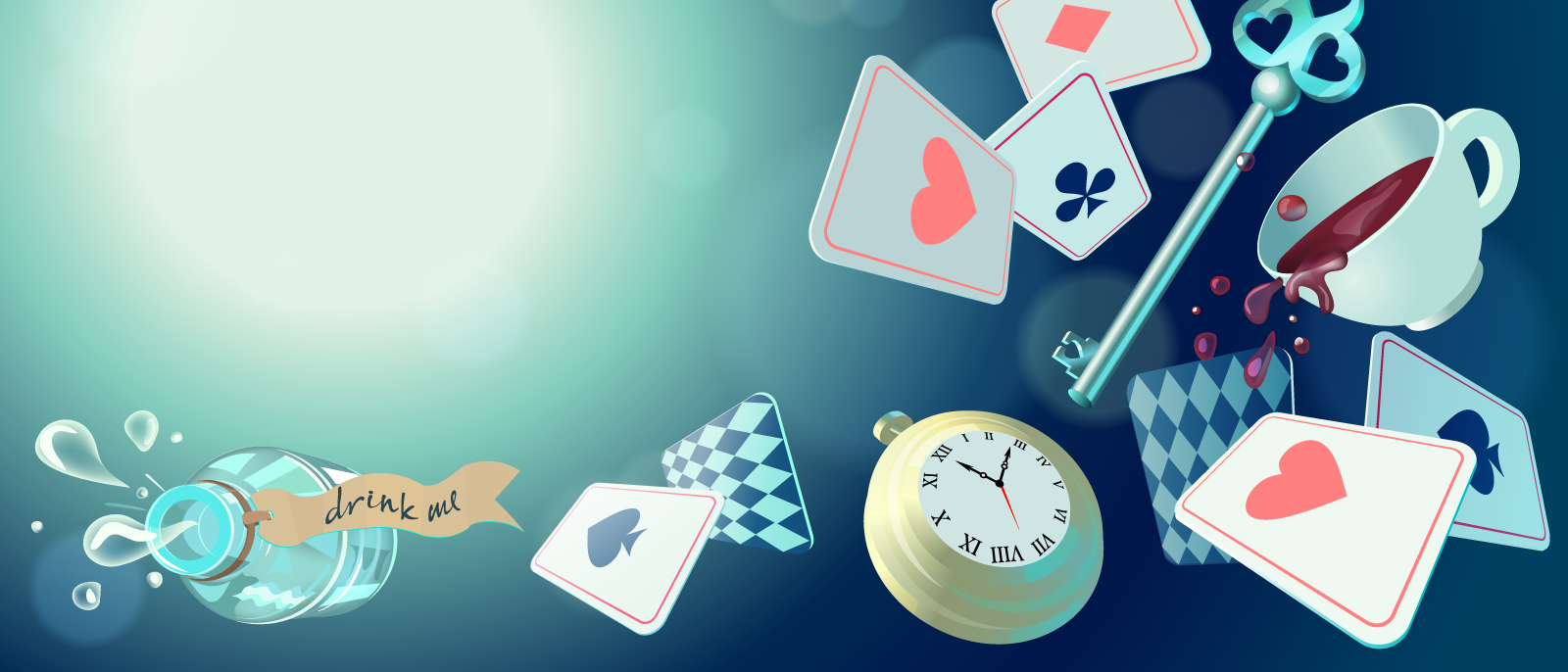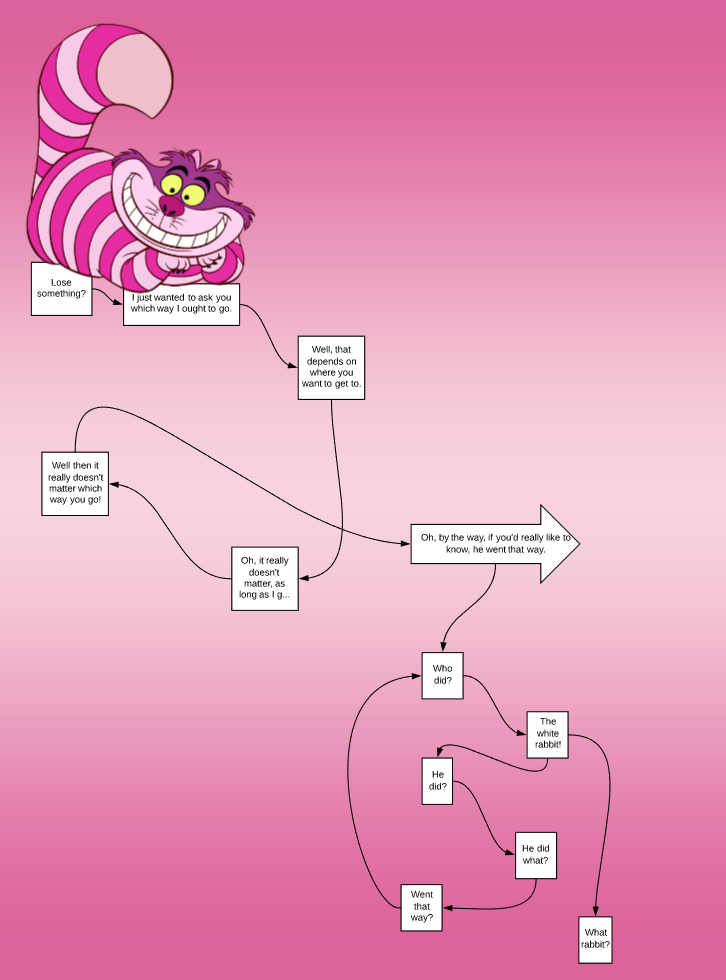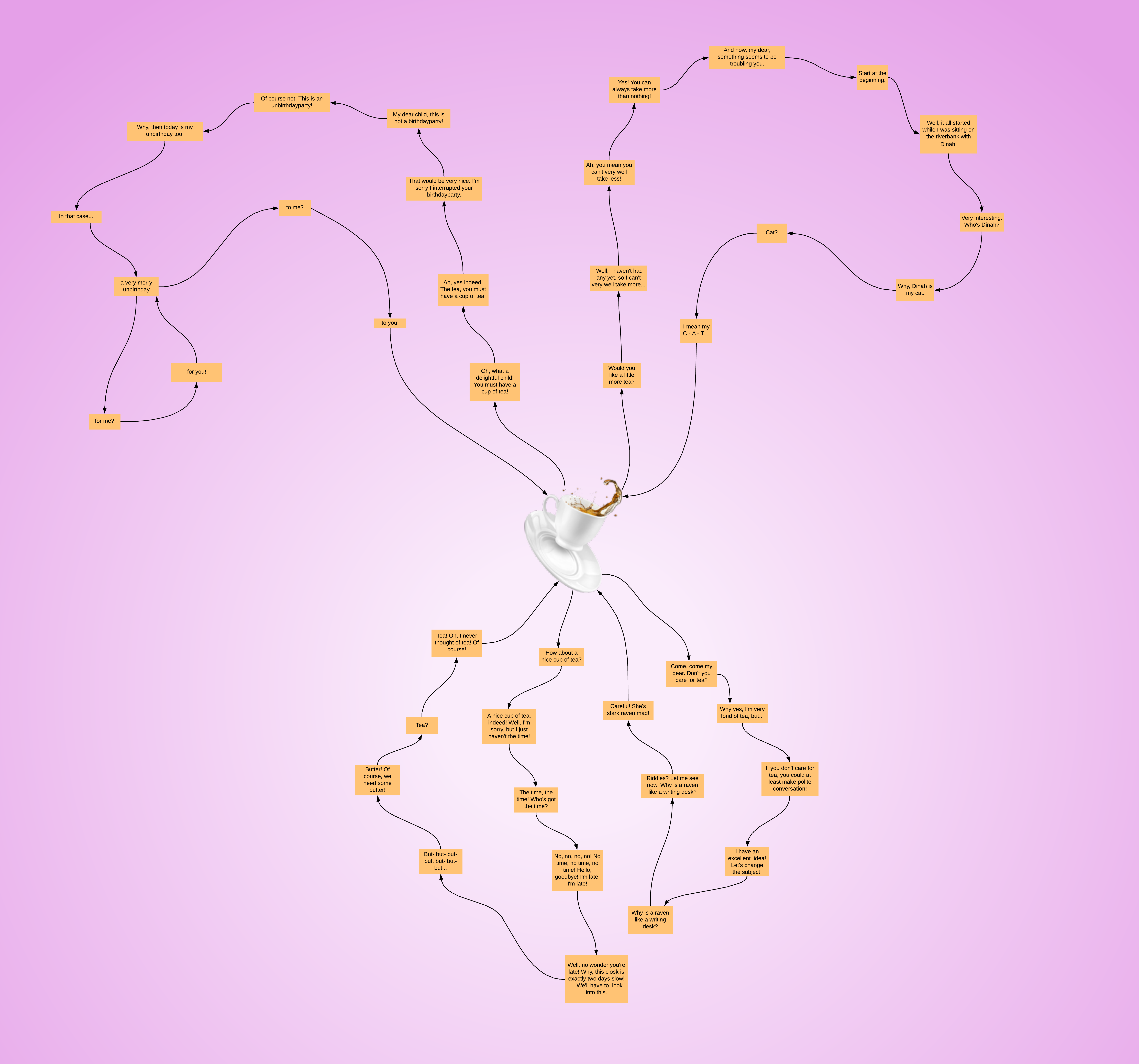
We’re All Mad Here: Using Lucidchart to Understand the Madness of Wonderland
Annika Wildenradt
Reading time: about 5 min
At the beginning of the 1951 Disney adaptation of Lewis Carroll’s Alice in Wonderland, Alice’s sister chastises Alice for daydreaming during her history lesson. Unapologetically, Alice replies, “How can one possibly pay attention to a book with no pictures in it?” She goes on to declare, “In my world, the books would be nothing but pictures.” When her sister chalks up the notion of Alice’s “own world” as “nonsense,” Alice muses:
“If I had a world of my own, everything would be nonsense. Nothing would be what it is, because everything would be what it isn't.”

Alice’s daydream is realized when she falls down a rabbit hole and finds herself in the topsy-turvy world of Wonderland, where rules and logic do not seem to apply. But after a series of strange encounters, from conversations with a hookah-smoking caterpillar and an evaporating cat to an unbirthday celebration with a hatter and a hare, Alice declares, “I’ve had enough nonsense. I’m going home.”
Poor Alice, is there no middle ground between suffocating banality and nonsense? As far as she can tell, there isn’t. Stuck looking at Wonderland through the lens of reality, influenced by the rules that raised her, Alice sees nothing but madness when she journeys through the unfamiliar realm. If only Alice had lived a half century later, she could have used Lucidchart to transcend her point of view and recognize the alternative logic guiding the world of Wonderland.
One belief from her past that restricts Alice’s perception of Wonderland is her concept of identity as a constant, rigid entity. This concept is challenged early on in her adventure, when Alice, who finds herself too large to fit into the door at the bottom of the rabbit hole, drinks from a bottle labeled “drink me” and shrinks until she is just a few inches tall.

She then takes a bite of a cake that makes her grow to monstrous proportions before she finishes off the bottle and becomes small once more. Confused by these changes, Alice fumbles to respond when the Caterpillar asks, “Who are you?” Alice awkwardly stutters, “I- I- I hardly know sir! I changed so many times since this morning, you see…”
The Caterpillar does not see. He goes on to ask more questions of Alice, and circles back to the question “Who are you?” over and over again, disregarding her responses. Flustered by the Caterpillar’s questions and her inability to answer them, Alice eventually exclaims, “Oh dear. Everything is so confusing.”
Unable to look at this encounter from a different point of view, Alice sees the Caterpillar’s questions as pointless and unanswerable. If she had mapped out this conversation using Lucidchart, she would have seen its underlying logic.
Centered on the question, “Who are you?” the Caterpillar’s logic takes on the shape of a figure eight, mirroring his looping hookah hose and the lazy smoke rings emanating from his relaxed, o’d lips. This logic, which is circular rather than linear, supports the existence of questions that do not have a single right answer but rather have multiple answers that are constantly in flux. According to this logic, Alice’s desire to answer the question “who are you” correctly is silly and futile.
Alice’s encounter with the Cheshire Cat is another missed opportunity for diagramming-induced enlightenment. Appearing on a tree branch above Alice, who is wandering fretfully through the woods, the Cheshire Cat asks, “Lost something?”
“I just wanted to ask you which way I ought to go,” Alice says, indicating that there is one proper path for her to follow. Challenging this notion, the Cheshire Cat replies playfully, “That depends on where you want to get to.” When Alice says that it “really doesn’t matter,” he asserts, “Then it really doesn’t matter which way you go!”
Had she been able to visually map out this conversation, Alice would have noticed a circular pattern akin to the Caterpillar’s looping hookah rings, in which multiple paths lead to the same destination and multiple destinations arise from each path. This map would have helped her see that in Wonderland, like the notion of a stable identity, there is an elusiveness to the notion of a single, correct way.
The limitations of Alice’s insular perspective bring her to a breaking point when she joins the Mad Hatter, the March Hare, and the Dormouse for tea. Alice, whose reason for seeking out these characters is to track down the White Rabbit, becomes fed up with the seemingly purposeless nature of the tea party and proclaims when she leaves, “Of all the silly nonsense, this is the stupidest tea party I’ve ever been to in all my life.” Had Alice been able to regard the event through the lens of a Lucidchart diagram, she would have recognized the same circular logic that guided her previous encounters in Wonderland.
At the center of the diagram is the topic of tea; no matter where it strays, the focus of the celebration inevitably returns to this topic. Just as the Caterpillar is content to exist in a state of perpetual questioning, unconcerned with finding answers, the tea party participants are blissful in their repetitive festivities. However, unable to relinquish her planned path, Alice is blind to this pattern and sees the tea party as a roadblock rather than a celebration.
During her journey through Wonderland, the rules and beliefs that Alice brought with her from the real world prevent her from noticing or appreciating the patterns and truths around her. Through her eyes, Wonderland is a place of pure nonsense, a place where she does not belong.
If Alice had seen Wonderland through the lens of Lucidchart, she could have escaped the confines of her perspective, seen the patterns guiding the nonsense, and gained wisdom from her experiences.
Lucidchart wasn’t there for Alice, but it is here for you. Free your mind from constrained patterns of thought and unlock possibilities previously unknown. Use Lucidchart, and open your mind to Wonderland.
**All quotes found here.
Try LucidchartAbout the author

San Francisco native and recent English graduate of the University of Michigan, Annika Wildenradt is now working as a content specialist on the customer ops team at Lucid. Outside of work Annika likes to travel, bake pies, write stories for kids, and paint pictures of make-believe creatures and worlds.
About Lucidchart
Lucidchart, a cloud-based intelligent diagramming application, is a core component of Lucid Software's Visual Collaboration Suite. This intuitive, cloud-based solution empowers teams to collaborate in real-time to build flowcharts, mockups, UML diagrams, customer journey maps, and more. Lucidchart propels teams forward to build the future faster. Lucid is proud to serve top businesses around the world, including customers such as Google, GE, and NBC Universal, and 99% of the Fortune 500. Lucid partners with industry leaders, including Google, Atlassian, and Microsoft. Since its founding, Lucid has received numerous awards for its products, business, and workplace culture. For more information, visit lucidchart.com.
Related articles
Mapping My Way to Mental Clarity
When Annika feels the familiar tightness of anxiety creep into her chest, she has found that creating an anxiety map helps her calm her stress and think clearly as she organizes the tangle of thoughts in her head.
Mind Mapping as a Tool for the Writing Process
Check out how Annika, a recent English graduate of the University of Michigan, used mind mapping in Lucidchart to develop her honors thesis.



